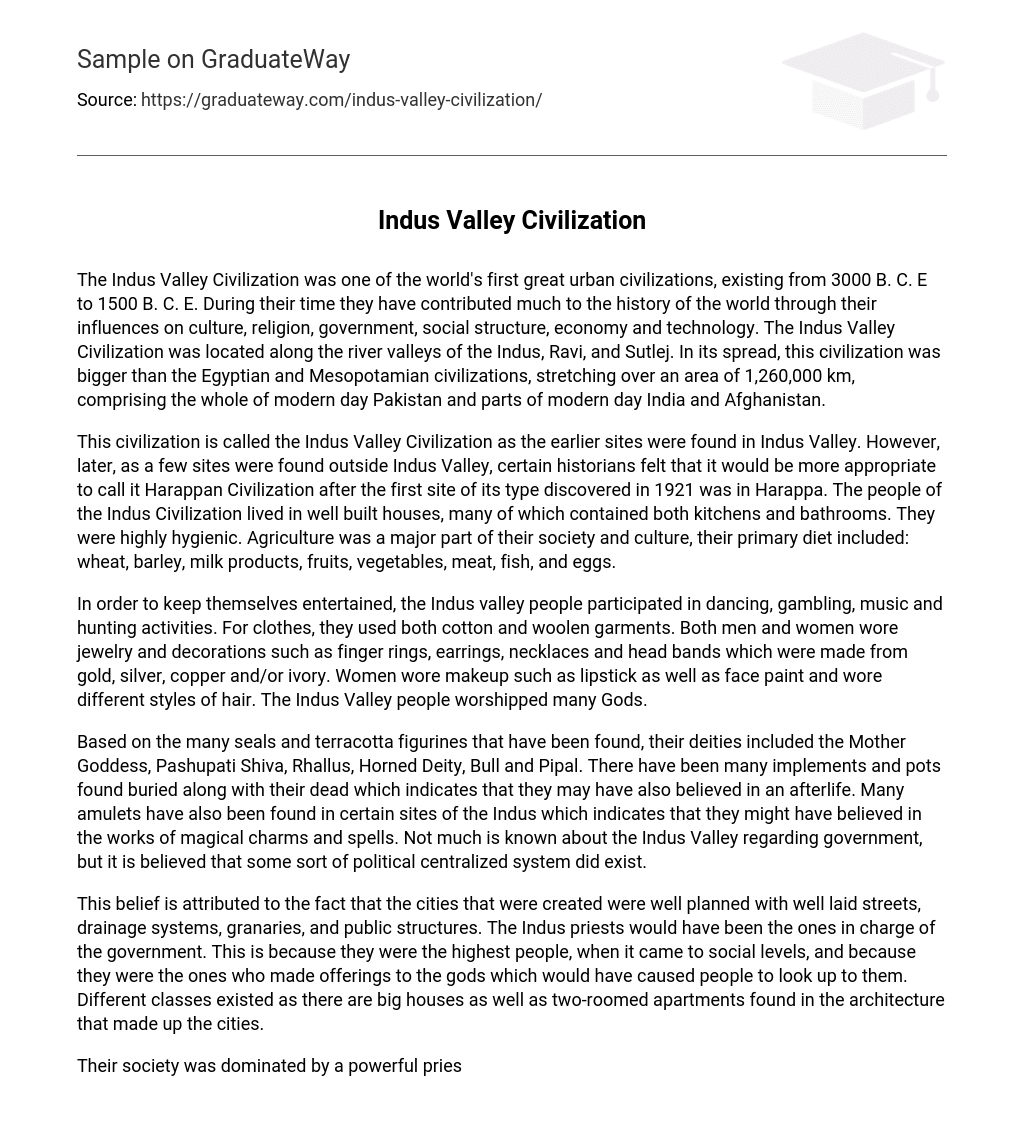The Indus Valley Civilization was one of the world’s first great urban civilizations, existing from 3000 B. C. E to 1500 B. C. E. During their time they have contributed much to the history of the world through their influences on culture, religion, government, social structure, economy and technology. The Indus Valley Civilization was located along the river valleys of the Indus, Ravi, and Sutlej. In its spread, this civilization was bigger than the Egyptian and Mesopotamian civilizations, stretching over an area of 1,260,000 km, comprising the whole of modern day Pakistan and parts of modern day India and Afghanistan.
This civilization is called the Indus Valley Civilization as the earlier sites were found in Indus Valley. However, later, as a few sites were found outside Indus Valley, certain historians felt that it would be more appropriate to call it Harappan Civilization after the first site of its type discovered in 1921 was in Harappa. The people of the Indus Civilization lived in well built houses, many of which contained both kitchens and bathrooms. They were highly hygienic. Agriculture was a major part of their society and culture, their primary diet included: wheat, barley, milk products, fruits, vegetables, meat, fish, and eggs.
In order to keep themselves entertained, the Indus valley people participated in dancing, gambling, music and hunting activities. For clothes, they used both cotton and woolen garments. Both men and women wore jewelry and decorations such as finger rings, earrings, necklaces and head bands which were made from gold, silver, copper and/or ivory. Women wore makeup such as lipstick as well as face paint and wore different styles of hair. The Indus Valley people worshipped many Gods.
Based on the many seals and terracotta figurines that have been found, their deities included the Mother Goddess, Pashupati Shiva, Rhallus, Horned Deity, Bull and Pipal. There have been many implements and pots found buried along with their dead which indicates that they may have also believed in an afterlife. Many amulets have also been found in certain sites of the Indus which indicates that they might have believed in the works of magical charms and spells. Not much is known about the Indus Valley regarding government, but it is believed that some sort of political centralized system did exist.
This belief is attributed to the fact that the cities that were created were well planned with well laid streets, drainage systems, granaries, and public structures. The Indus priests would have been the ones in charge of the government. This is because they were the highest people, when it came to social levels, and because they were the ones who made offerings to the gods which would have caused people to look up to them. Different classes existed as there are big houses as well as two-roomed apartments found in the architecture that made up the cities.
Their society was dominated by a powerful priestly class that ruled and dominated social structures, and political systems. The Indus Valley is said to have had a vast Middle Class society and had a strong Trader class; which were merchants who sailed far and wide to trade with Mesopotamia, Egypt as well as other far off places. Then there were the Farmers followed by craftsmen and artisans. Agriculture was the chief occupation of the Indus Valley people. They were able to grow many crops next to the Indus River which provided a plentiful amount of food for the population which was stored centrally in large buildings.
Pottery, weaving, brick laying, bread making and metal crafts were completed by the more urbanized individuals of the cities. Both internal and external trade existed which allowed the economy to prosper. They used routs panning over both land and sea. They exported cotton, ivory, combs, peacocks, and copper and imported metals like silver with lands such as Egypt and Mesopotamia. A sophisticated and technologically advanced urban culture is evident in the Indus Valley Civilization. They had craftsmen skilled in pottery, weaving, and metal working. They used camels, oxen and elephants to travel over land. They had carts with wooden wheels.
They had ships with one mast which they probably used to sale long distances. Their houses could be one or two stories high, made of baked bricks with flat roofs. Each home had its own drinking well and had clay pipes which led from the bathroom to the sewers located under the streets, which then drained into rivers and streams. The people of the Indus civilization achieved great accuracy in measuring length, mass and time. After careful study of tides, waves and currents they were also able to build docks and walls to protect against flooding. The Indus valley civilization contributed much to the history of the world.
They gave the world its earliest sites, its first urban civilization, its first town planning, its first architecture in stone and brick as protection against floods, the cultivation of cotton, its first example of sanitary engineering and drainage works. They were the first to produce pottery. Their way of creating baked pottery, as well as bricks, beads, jewelry and textiles were so advanced that it was later adapted by other civilizations. Even the maritime trade relations with Central and West Asia began because of these people. In the field of religions many important features of Indus religion were adopted into Hinduism.
The Indus worshipped Pashupati Shiva in his actual form as well as in the representative form as Linga, worship of mother goddess, worship of trees, animals; serpents were all adopted by Hinduism. The people of Indus Valley influenced all these things and more, forever stabilizing their worth in the books of history. Bibliography http://www. csuchico. edu/~cheinz/syllabi/asst001/fall97/2chd. htm http://www. crystalinks. com/induscivilization. html http://india. mrdonn. org/indus. html http://dilipchandra12. hubpages. com/hub/Ancient-Indus-Valley-Civilization





